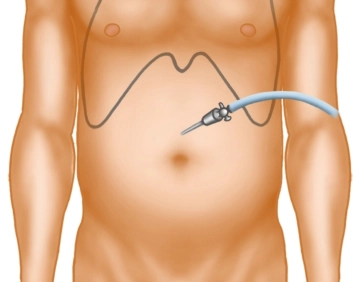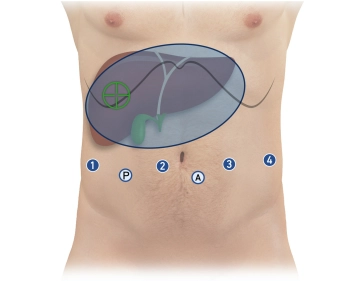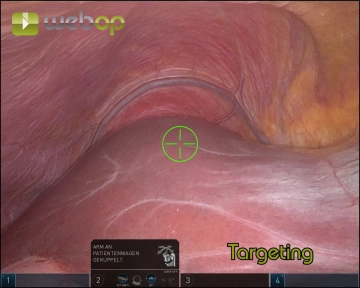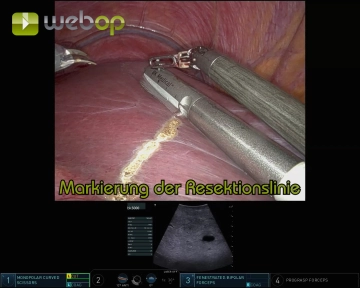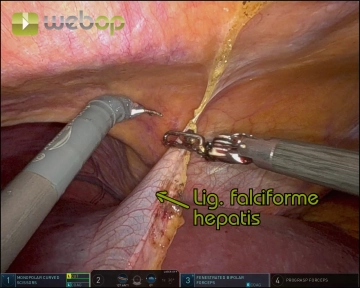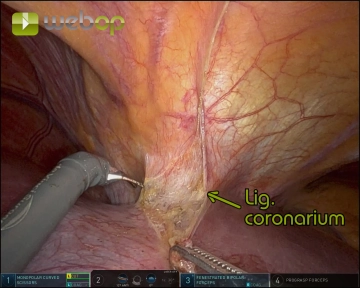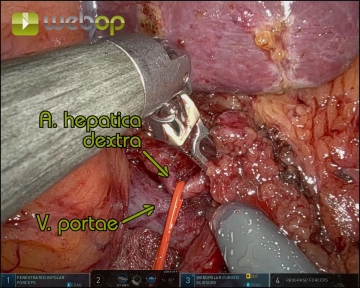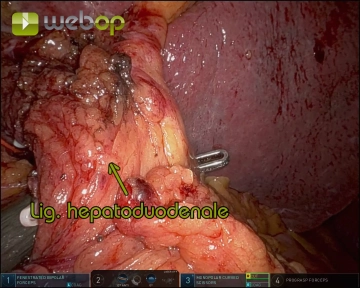- Positioning: Supine position with legs spread on a vacuum cushion. The cushion ensures stability, reducing the need for additional supports
- After trocar placement, the table is tilted to a 15° – 30° Anti-Trendelenburg position to optimize access
- Robot Docking:
- The Xi system offers flexibility in the docking position, typically from the left
- For X or Si systems, the cart is docked cranially from the right
- Team Positioning:
- Surgeon: At the console, ideally with a view of the patient and assistant
- Assistant: Positioned between the legs, sitting or standing
- Scrub Nurse: On the right side of the patient
- Anesthesiologist: At the patient’s head, on the right side
-
Patient Positioning and Operating Room Setup
-
Pneumoperitoneum, Trocar Placement, and Docking
![Pneumoperitoneum, Trocar Placement, and Docking 1]()
![511_Trokarpositionen.jpeg]()
![Pneumoperitoneum, Trocar Placement, and Docking 3]()
Soundsettings Pneumoperitoneum Creation:
- Use a Veress needle at the Palmer point in the left upper abdomen.
- Establish an insufflation pressure of 12–15 mmHg
- Alternatively, employ Optiview technique
Trocar Placement:
- Total Ports:
- Four 8 mm robotic ports in a linear arrangement, 15–20 cm from the target anatomy (infraumbilical)
- Two 12 mm laparoscopic ports:
- Assistant trocar (caudal between robotic ports 2 and 3)
- Pringle maneuver trocar (caudal between robotic ports 1 and 2)
- Spacing: Approximately 8 cm between each port
- Position robotic trocars at the level of the muscular abdominal wall (aligning the broad black ring, the “Remote Center”)
Initial Instrument Configuration:
- Robotic ports (from right to left):
- Port 1: Monopolar curved scissors
- Port 2: Camera
- Port 3: Bipolar forceps
- Port 4: Prograsp forceps
Docking the Robot:
- Dock the camera arm first (port 2)
- Execute Targeting (Xi system) to align robot arms with the surgical target
- Dock the remaining arms, ensuring 1 fist-width spacing between them
- Insert instruments under direct visualization via the assistant trocar
Key Precautions and Tips
Trocar Stability:
- Ensure the “Remote Center” aligns with the muscular abdominal wall to minimize shear forces during instrument movement
Instrument Placement:
- Use the assistant trocar and camera to inspect trocar alignment and verify instrument positioning before proceeding
Preventing Patient Movement:
- Double-check the vacuum cushion for leaks before sterile draping
- Secure arms during docking to avoid injury if the patient shifts
Control Checks:
- Before docking:
- Mark trocar points and ensure proper spacing
- Introduce the camera manually for inspection
- After docking:
- Verify arm alignment and positioning of instruments
-
Pre-Docking Checklist
- Perform a small incision in the left upper abdomen for Veress needle placement
- Establish pneumoperitoneum at 15 mmHg
- Mark the trocar line and insert the first robotic trocar
- Insert the camera manually to confirm placement
- Sequentially place:
- Three additional robotic trocars (8 mm)
- Two laparoscopic trocars (12 mm) in the caudal positions
- Transition to Anti-Trendelenburg position (15°)
- Dock the camera arm and insert the camera
- Perform Targeting with the Xi system
- Dock the remaining three arms
- Insert instruments and park them at the target anatomy:
- Port 1: Monopolar curved scissors
- Port 2: Camera
- Port 3: Bipolar forceps
- Port 4: Prograsp forceps
- Inspect remote centers via the assistant trocar to ensure proper alignment
This systematic approach optimizes patient safety, instrument positioning, and robot utilization, ensuring precision in robotic-assisted right hemihepatectomy.
-
Intraoperative Sonography and Marking the Resection Line
![Intraoperative Sonography and Marking the Resection Line]()
Soundsettings Adhesiolysis:
- Release adhesions between the omentum majus, gallbladder, and inferior liver surface
- Grasp the gallbladder fundus with the Prograsp Forceps and retract cranially
- Expose the entire gallbladder to the infundibulum
Intraoperative Ultrasound:
- Insert the ultrasound probe through the assistant trocar
- Guide the probe with fenestrated bipolar forceps for precise movement
- Objective:
- Visualize lesions and their relationship to vessels and bile ducts
- Confirm the tumor-free status of the left liver lobe
- Identify critical landmarks, including the middle hepatic vein and segmental branches to Segments V/VI and VIII
Marking the Resection Line:
- Using monopolar scissors, mark the resection line on the ventral liver capsule under ultrasound guidance
-
Division of the Ligamentum teres and Ligamentum falciforme hepatis
![Division of the Ligamentum teres and Ligamentum falciforme hepatis]()
Soundsettings Create a window between the ligamentum teres and the abdominal wall
Gradually divide both ligaments with meticulous coagulation, progressing from caudal to cranial up to the diaphragm and coronary ligament
- Tip: Use the detached ligamentum teres as a traction point for atraumatic manipulation of the liver during the procedure
-
Exposure of the suprahepatic inferior vena cava
-
Hilar Dissection
![Hilar Dissection]()
Soundsettings Access and Exposure:
- Elevate the liver using the Prograsp Forceps on the ligamentum teres
- Open the omentum minus over Segment I (Lobus caudatus)
Cystic Structures:
- Identify and clip the cystic duct and cystic artery using the large clip applier
- Use ICG fluorescence imaging to confirm bile duct anatomy
Resection Line on Inferior Surface:
- Mark the resection line 1 cm lateral to the gallbladder bed on the inferior liver surface
Hepatic Structures:
- Identify:
- Proper hepatic artery and its bifurcation into right and left branches
- Right portal vein branch (and its anterior and posterior branches if present)
- Dissect these structures using bipolar Maryland forceps, ensuring precision
- Encircle major vessels with vessel loops for controlled manipulation
Right Hepatic Artery:
- Ligate and divide the right hepatic artery after ensuring appropriate demarcation of the right liver
Right Portal Vein:
- Ligate and divide the right portal vein branch using two proximal and one distal clip
-
Retrohepatic Mobilization
![Retrohepatic Mobilization]()
Soundsettings Liver Mobilization:
- Elevate the Lobus caudatus and mobilize it by dividing connective tissue adhesions
- Sequentially expose and clip retrohepatic veins using Haemolock clips, progressing from caudal to cranial
Full Mobilization:
- Complete retrohepatic dissection, separating the right liver lobe from the Gerota’s fascia alongside the vena cava from caudal to cranial
-
Transection of the Right Hepatic Artery
![Transection of the Right Hepatic Artery]()
Soundsettings In this case, the right hepatic artery was temporarily clamped using a bulldog vascular clamp to identify demarcation of the right liver. The bulldog clamp on the right hepatic artery was then released. A large clip applier was introduced through Port 1. The artery was transected between the clips. The loop was then transected and removed.
-
Pringle Maneuver Setup
![Pringle Maneuver Setup]()
Soundsettings - Pass a Mersilene band through the foramen of Winslow (omentum foramen)
- Thread the band through a 12 Ch thoracic drain and extend it outside the abdomen via the laparoscopic trocar between robotic ports 1 and 2
- Ensure the band is long enough by knotting two bands together if necessary
- The Pringle maneuver can be activated by the table assistant to occlude hepatic blood flow when needed
Right Hepatic Artery Control:
- Initially clamp with a Bulldog vascular clamp to verify right lobe demarcation
- Clip and divide the artery using the large clip applier
Precautions and Tips:
- Ensure the common bile duct (DHC) is not compromised, especially in cases where the right hepatic artery passes beneath it—a common anatomical variant
- Sequentially verify vessel anatomy and use meticulous dissection to avoid unintended injury
Conduct a second ultrasound before parenchymal transectionVisualize:Intrahepatic vasculature, inclu
Activate now and continue learning straight away.
Single Access
Activation of this course for 3 days.
Most popular offer
webop - Savings Flex
Combine our learning modules flexibly and save up to 50%.
US$51.56/ yearly payment
robotics
Unlock all courses in this module.
US$103.10 / yearly payment


